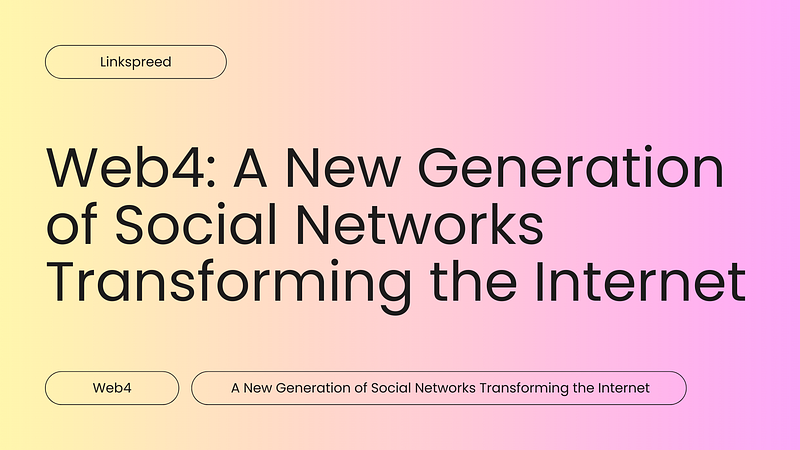Web4: A New Generation of Social Networks Transforming the Internet
The internet has come a long way since its inception. From the static pages of Web1 to the interactive platforms of Web2, and the decentralized promise of Web3, each evolution has brought new possibilities and challenges. Now, with the emergence of Web4, the internet is entering a new era — one centered on community-driven design, interoperability, and user empowerment.

At the forefront of this transformation is Linkspreed, a pioneer in Web4 technologies, driving a vision to create a decentralized internet where social networks are owned and controlled by their users. In this blog, we’ll explore the evolution of the internet, the unique features of Web4, and how Linkspreed is shaping this exciting future.
The Journey from Web1 to Web4
- Web1: The Internet of Information
Web1 was the starting point — static, read-only web pages that served as digital libraries. Users could access information but had little to no interaction with the content. - Web2: The Internet of Interaction
With Web2 came social platforms like Facebook, Twitter, and YouTube. This era brought user-generated content and interactivity but was dominated by centralized platforms controlling user data and monetization. - Web3: The Internet of Ownership
Web3 introduced decentralization, leveraging blockchain technology to give users ownership of their data and digital assets. However, its complexity and lack of accessibility kept it from widespread adoption. - Web4: The Internet of Community
Web4 combines the strengths of its predecessors while addressing their limitations. It focuses on community-driven networks, interoperability, and user-friendly design, making decentralization and user control more accessible than ever before.
What Makes Web4 Unique?
Web4, as envisioned by Linkspreed, is not just about connecting people — it’s about empowering them to create and control their own networks. Here’s what sets it apart:
- Hyper-Local Networks
Web4 allows communities, organizations, and businesses to build their own social platforms tailored to their needs. These networks are interoperable, decentralized, and free from the dominance of tech giants. - User Empowerment
Unlike Web2, where user data is controlled by centralized platforms, Web4 gives full control back to the users. Every network is owned and governed by its community. - Interoperability
Networks built on Web4 can communicate seamlessly with one another, fostering collaboration and innovation without technical restrictions. - Accessibility
Web4 is designed to be user-friendly. With tools like Web4 Lite from Linkspreed, anyone can create their own network without technical expertise, making decentralization more accessible to the masses.
Linkspreed’s Vision for the Future
Linkspreed’s mission is clear: to redefine social networks and build an internet centered on people and communities. Through innovative tools and initiatives like the Denmark 4.0 project, Linkspreed is setting the stage for a decentralized, user-first digital ecosystem.
Web4 is not just an evolution — it’s a revolution. It bridges the gap between the best aspects of Web2 and Web3, creating a future where the internet is owned and shaped by its users.
Conclusion
As we step into the era of Web4, the internet is becoming a place where individuals and organizations can thrive in their own digital spaces. Linkspreed is leading this charge, turning the promise of Web4 into a reality.
Are you ready to join the future of the internet? Dive deeper into Web4 and explore how it’s transforming social networks, one community at a time.
Listen to the full podcast on Web4 here: https://youtu.be/VrVjv-vFXCE
Others posts
The Grand Vision Behind Web4: Championing Freedom of Speech @Linkspreed - Aug 25, 2024
The internet has always been a powerful platform for communi...
12 Community Management Best Practices for 2025: Building Thriving Web4 Communities @Linkspreed - Feb 23, 2025
In today’s hyper-connected world, building a thriving...